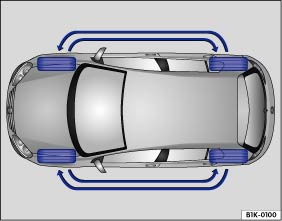Volkswagen Polo Owners Manual: Handling wheels and tyres

Fig. 145 Diagram showing how to swap wheels
 First read and observe the introductory information
and safety warnings
First read and observe the introductory information
and safety warningsThe tyres are the most used and most underestimated parts of a vehicle. Tyres are very important as the narrow tyre surfaces are the only contact between the vehicle and the road.
The service life of tyres is dependent on tyre pressure, driving style handling and fitting.
The tyres and wheel rims are an essential part of the vehicle's design. The tyres and rims approved by Volkswagen are specifically matched to the characteristics of the vehicle and make a major contribution to good road holding and safe handling.
Avoiding damage to the tyres
- If you have to drive over a kerb or similar obstacle, drive slowly and at a right angle if possible.
- Inspect the tyres regularly for damage such as cuts, cracks or blisters.
- Remove foreign objects that are in the outer tyre tread and have not penetrated the inner tyre .
- Always respond to any warning messages given by the tyre monitoring system .
- Damaged or worn tyres must be replaced immediately .
- Regularly check the tyres for hidden damage .
- Never exceed the top speed and load permitted for the tyres that are fitted .
- Protect the wheels, including the spare wheel, from contact with corrosive substances, including oils, lubricants, fuel and brake fluid .
- Replace missing dust caps immediately.
Tyres with directional tread pattern
Tyres with directional tread pattern have been developed to roll in one direction only. An arrow on the tyre sidewall indicates the direction of rotation on tyres with directional tread . The direction of rotation must be adhered to. This is the only guarantee for optimum grip and helps to avoid aquaplaning, excessive noise and wear.
If, however, the tyre is fitted in the opposite direction to the tread pattern, you must take more care when driving as the tyre is now no longer being used according to its designation. This is particularly important on wet roads. The tyres must be replaced as quickly as possible or be fitted with the tread in the correct direction.
Rotating wheels front to rear
Regularly rotating the wheels as shown in the illustration is recommended to help ensure that tyres wear evenly. All the tyres will then last for about the same time.
Volkswagen recommends having the wheels changed by a qualified workshop.
Tyres that are older than 6 years
Tyres age through physical and chemical processes that can impair their function. Tyres that are stored unused for an extended period will harden and become brittle more quickly than tyres which are in constant use.
Volkswagen recommends replacing tyres that are older than 6 years with new tyres. This also applies to tyres, including the spare wheel, which appear to still be in good condition and whose tread depth has not yet reached the minimum value stipulated by legislation .
The age of a tyre can be determined from the manufacturing date, which is a component
of the tyre identification number (

 ) .
) .
Storing tyres
Mark tyres before you remove them to indicate the direction of rotation. This ensures you will be able to mount them correctly when you replace them (left, right, front, rear). When removed, the wheels or tyres should be stored in a cool, dry and preferably dark place. Do not store tyres mounted on the rim vertically.
Any tyres not fitted on rims should be kept in suitable sleeves to protect against dirt and should be stored vertically (standing on the tread).

 WARNING
WARNING
- Always keep chemicals, oils, lubricants, fuel, brake fluid and other corrosive substances away from the tyres.

 WARNING
WARNING
- Avoid using tyres that are more than six years old. If you have no alternative, drive slowly and with extra care at all times.

Old tyres should be disposed of as required by legislation.
 Introduction
Introduction
This chapter contains information on the following subjects:
→ Handling wheels and tyres
→ Rims
→ New wheels and tyres
→ Tyre pressure
→ Tread depth an ...
 Rims
Rims
First read and observe the introductory information
and safety warningsThe design of the wheel bolts is matched to the rims.
If different rims are fitted, the correct wheel bolts with the right le ...
Other materials:
Ultrasound A/C Cleaner -VAS6189B
The Ultrasonic HVAC Cleaning System -VAS6189A- is placed in
the front passenger footwell and sprays Aero-Clean. Aero-Clean
neutralizes microbes and bacteria inside the heater and A/C
unit.
The unit comes with Operating Instructions.
...
Reservoir
Caution
Non-approved tools or materials such as leak sealing
additives can cause damage or malfunctions in the
system.
Only use tools and materials approved by the
manufactu ...
Two-Part Wash Primer
Definition:
Two-Part Wash Primer -LHV 043 000 A2-
Edition 10/2010
Product Description
The two-part wash primer is a zinc chromate-free,
phenol-free and acid-free two-componen ...
